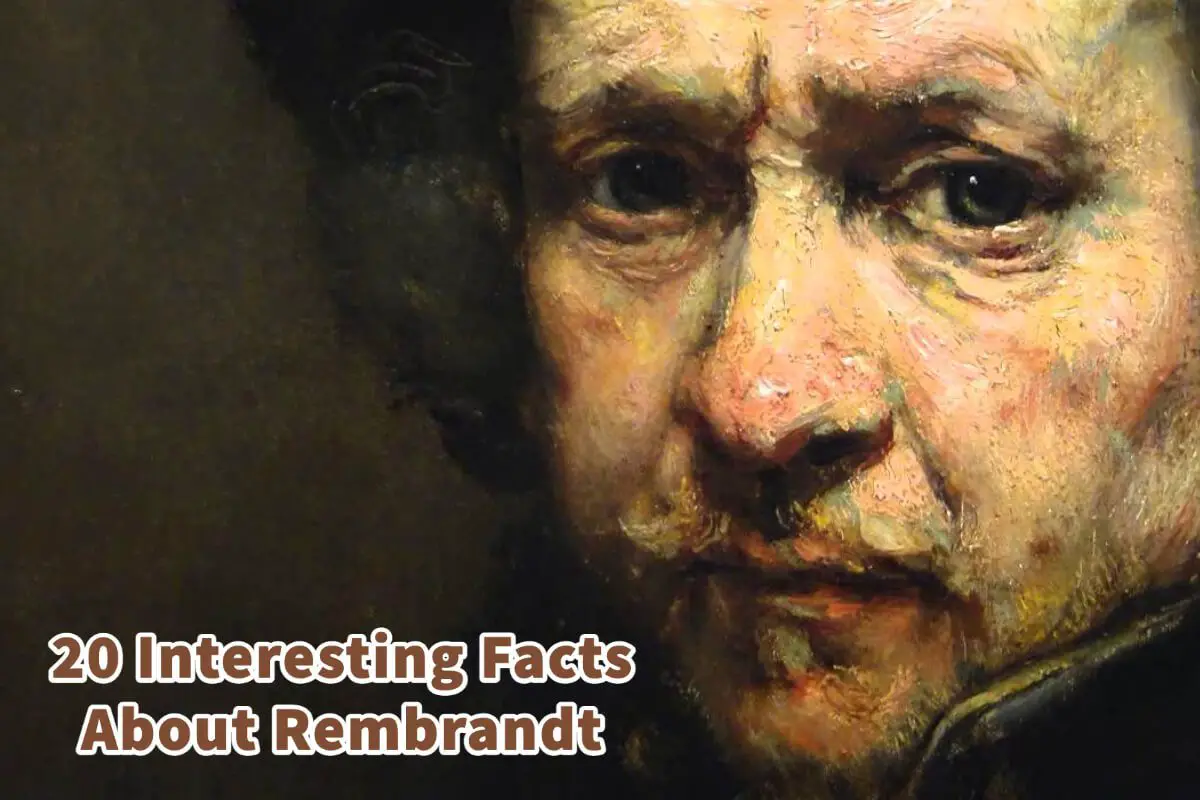Rembrandt is one of the most famous painters who has ever lived. Rembrandt’s life is filled with many interesting facts.
Like many artists who have lived, their lives and art make a fascinating history. Rembrandt was not only an exceptional artist but also had quite a fascinating history filled with interesting facts.
Table of Contents
- 20 of our most interesting facts about the Dutch painter Rembrandt
- Rembrandt Is Know By One Name
- Rembrandt Lived In 17th Century Holland.
- Rembrandt’s Favorite Subject Was Himself
- He Started At The University Of Leiden At Age 14
- Rembrandt Stayed In Holland To Study Art
- Rembrandt Made Himself A Name As A Painter Of History
- Rembrandt Married An Art Dealer’s Younger Cousin
- Rembrandt Was Happily Married To Saskia
- Saskia Died And Left A Will For The Use Of Her Fortune
- Rembrandt’s Domestic Life Became Complicated
- Rembrandt Became One Of The Most Famous Artists In Amsterdam
- Rembrandt Was Known To Squander Money
- Rembrandt Was Declared Bankrupt
- Rembrandt’s Son Titus Was Left To Look After Him
- Rembrandt Painted Many Self-Portraits In The Last 20 Years of Life
- Rembrandt Could Have Suffered From Stereo Blindness
- Rembrandt’s Secretly Embedded Codes In His Works
- Caravaggio Influenced Rembrandt’s Paintings
- Rembrandt Taught Other Students
- Some Rembrandt Paintings May Be Works Of Others
- Frequently Asked Questions
- Related Questions
20 of our most interesting facts about the Dutch painter Rembrandt
As we delve into the captivating world of one of the most renowned painters in history, Rembrandt van Rijn, it’s not just his masterful artworks that draw our attention but also the intriguing aspects of his life and career.
Known for his profound influence in the Dutch Golden Age of painting, Rembrandt’s works are celebrated for their vivid realism and emotional depth. In this section, we will explore 20 fascinating facts about this Dutch master, shedding light on the lesser-known facets of his life and work.
Rembrandt’s journey as an artist was marked by groundbreaking techniques and a unique approach to chiaroscuro, which brought a dramatic intensity to his paintings. His self-portraits, biblical scenes, and landscapes are not just visually stunning; they are windows into the soul and psyche of the artist.
From his early beginnings to his impact on the art world, each fact we unveil contributes to a richer understanding of Rembrandt’s legacy.
Moreover, beyond the canvas, Rembrandt’s personal life was a tapestry of triumphs and trials, influencing his artistic output and shaping his approach to his subjects. Through these 20 intriguing facts, we will traverse the path of his artistic evolution, discover his influences, and uncover the stories behind some of his most iconic works.
This journey into Rembrandt’s world promises to be as enlightening as it is engaging, offering a deeper appreciation of one of the giants of the art world.
Rembrandt Is Know By One Name
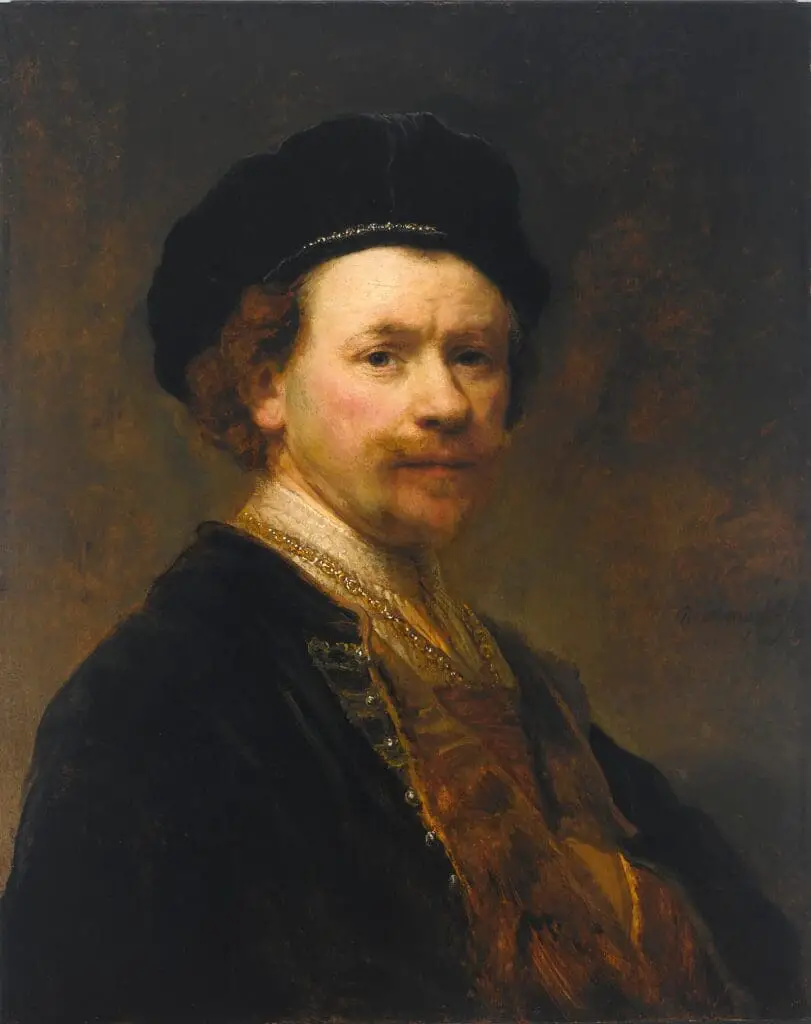
Rembrandt’s full name is Rembrandt Harmenszoon van Rijn. But like many other artists, he is known by only his first name – Rembrandt. The actual “d” on his name is silent, so he changed to sign his name in 1633 from Rembrant to Rembrandt. He never used the full version of his reputation for his artworks.
Rembrandt Lived In 17th Century Holland.
Rembrandt was born in 1606. His father was a miller and comfortably off, but his family was not wealthy. His parents were able to send Rembrandt to the town’s Latin school, where he could learn Latin.
Rembrandt’s Favorite Subject Was Himself
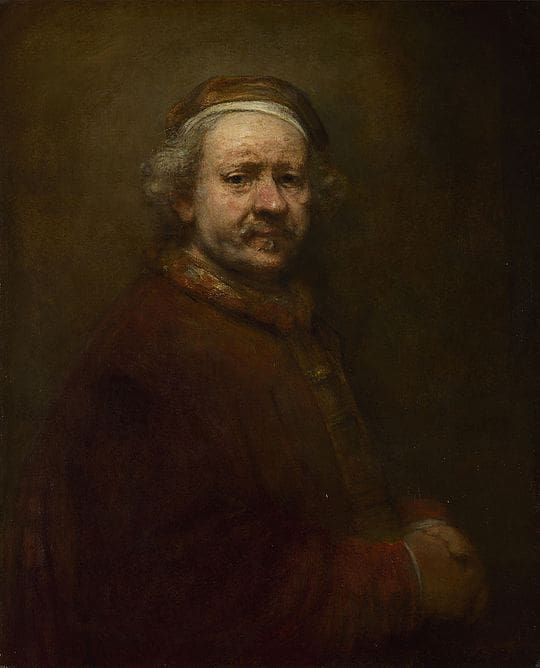
Undoubtedly, one of Rembrandt’s most famous subjects was himself. Many artists produced portraits of themselves, but Rembrandt was more prolific than most other artists.
There are more than 90 known self-portraits of Rembrandt. His love for painting his self-portraits did not end there because he also painted himself in many of his paintings. You can find a picture of him as a spectator in the crowd at various works of art, including The Stoning at Saint Stephen and The Rising of the Cross.
He Started At The University Of Leiden At Age 14
Rembrandt began studying at the famous University of Leiden in Holland at 14. This would have been highly unusual for the miller’s son to go to University. We know that academic life did not suit him, so after a few months, he left his university studies to begin an apprenticeship as a painter.
Rembrandt Stayed In Holland To Study Art
When Rembrandt decided to become a painter, the advice during that time was that he should go to Italy. He did not follow the advice given to young painters during that time; he felt he could learn everything about art in his native Netherlands.
Rembrandt Made Himself A Name As A Painter Of History
Because of the protestant reformation, the local church no longer provided artists with commissions as the Catholic Church did in other countries such as Italy. Consequently, artists had to find a way to get commissions from private individuals. Rembrandt quickly began to make a name for himself as a painter of historical subjects.
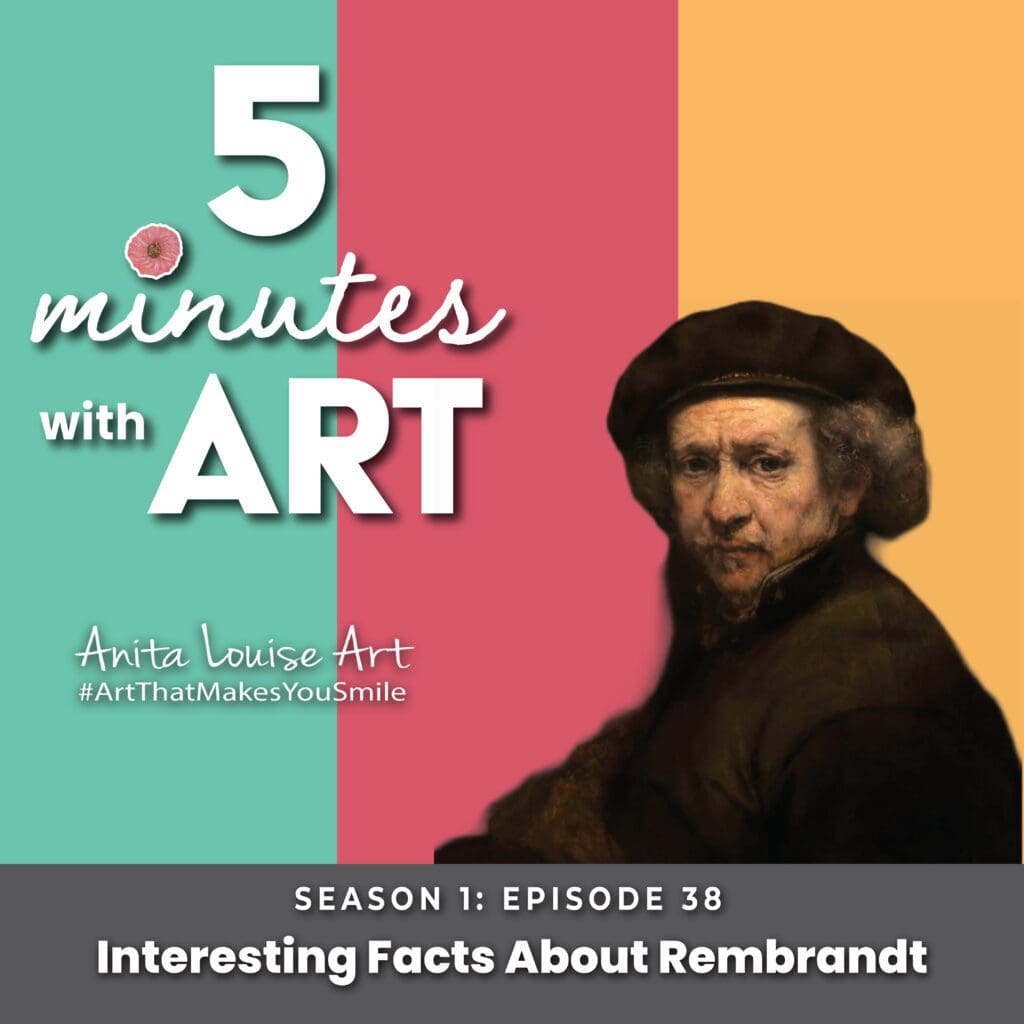
Listen To Our Podcast About Interesting Facts About Rembrandt by clicking here.
Rembrandt Married An Art Dealer’s Younger Cousin
In about 1631, Rembrandt decided to move from Leiden to Amsterdam. At that time, Amsterdam was the most prosperous port in Northern Europe and was crowded with merchants from every nation.

Amsterdam also offered young and successful artists the opportunity to sell their works of art. He moved into the home of an art dealer called Hendrick van Uylenburgh, and while there, he met his landlord’s younger cousin, Sasha. They were married in 1634.
Rembrandt Was Happily Married To Saskia
By all accounts, it seems that Rembrandt was happily married to Saskia; he produced many paintings and drawings of Saskia.

The couple gave birth to their first son, Rumbartus who died after two weeks. Over the next four years, more children were born but died shortly after birth. In 1641, their fourth child, Titus, was born and survived.
Saskia Died And Left A Will For The Use Of Her Fortune
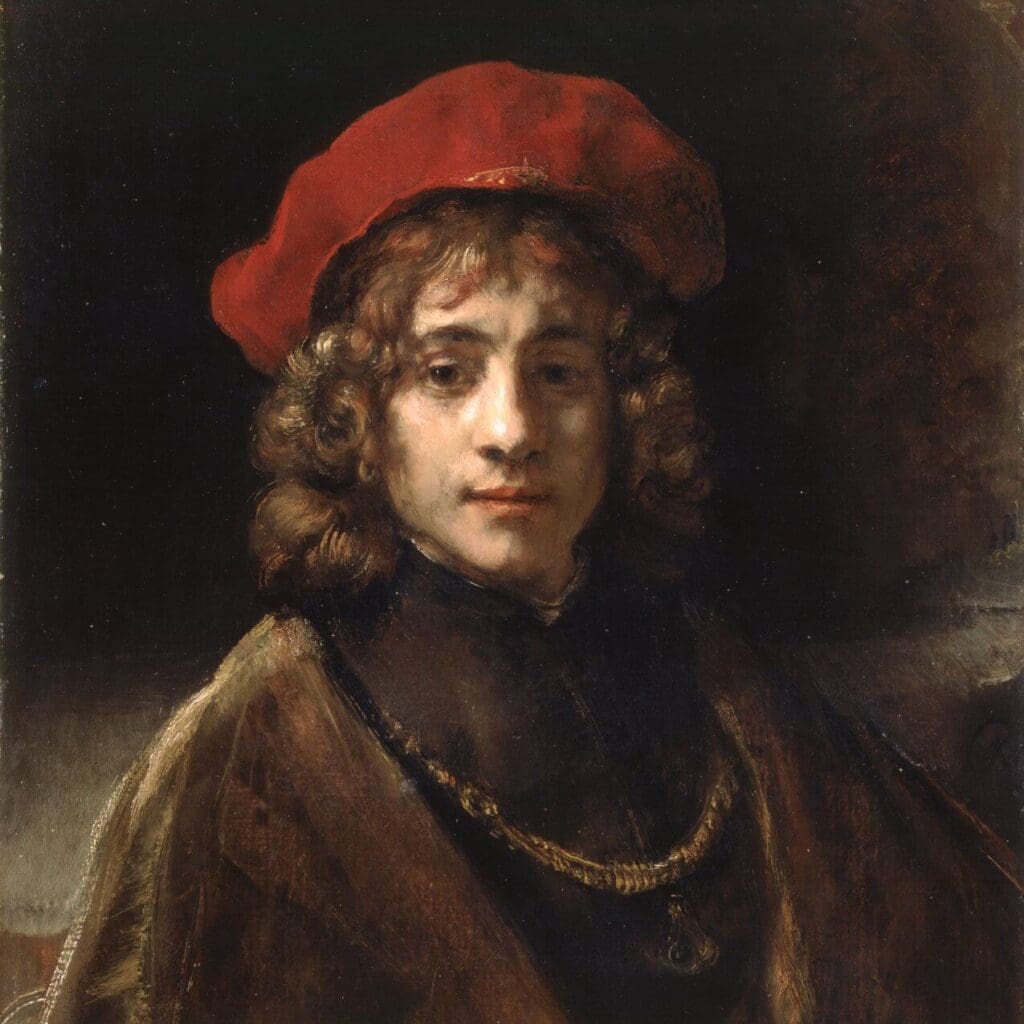
In 1642, shortly after Titus was born, Saskia died. She made a will that left Rembrandt and Titus her fortune but stipulated that Rembrandt’s share would be lost if he married again.
Rembrandt’s Domestic Life Became Complicated

After Saskia died, Rembrandt was left alone with a tiny baby to take care of. He took on a widow named Geertge Dircx; she became his common-law wife for a short time.
Rembrandt then took on another servant, Hendrickje Stoffels, and he fell in love with her. Geertge took Rembrandt to court because he had promised to marry her and had broken that promise with Herdrickje.
Rembrandt accused Geertge of stealing some of the Saskia jewelry that she left to Titus and had Geertge sent to the House of Corrections. Because of the strict terms of Saskia’s will, Rembrandt could not afford to marry Hendrickje, but they lived together, and she appeared in many of his paintings.
Rembrandt Became One Of The Most Famous Artists In Amsterdam
Rambadt quickly became one of Amsterdam’s most famous and essential artists. Professionally his life continued to go from strength to strength. He began to produce a variety of portraits and had many art commissions.
Rembrandt Was Known To Squander Money
Even though Rembrandt was considered highly successful with his art, he was known to spend and squander quite a bit of money. He was a compulsive buyer of arts and collected all manners of antiquities, props, and weapons used in his paintings.
Rembrandt had cash flow problems; Saskia had her own money, and her family accused him of squandering her fortune.
Rembrandt Was Declared Bankrupt
In the 1650s, Amsterdam was hit by a massive economic depression; this financial situation hit Rembrandt very hard. Rembrandt had not even completed half the payments on his house, so his creditors started to chase him for money.
In July 1656, Rembrandly successfully applied for “cessio bonorum,” a form of bankruptcy that allowed him to avoid prison time. All his goods, including an impressive collection of paintings, were sold off for a pittance. Rembrandt, Titus, and Hendrickje were forced to move across town to a poor district; Rembrandt continued to paint.
Rembrandt’s Son Titus Was Left To Look After Him
In 1663, Hendrickje died after a long and challenging illness. Titus was left to look after his father. Rembrandt had severe money problems and was forced to sell Saskia’s tomb. But even with the money problems, he continued squandering money on artifacts and art.
In 1668, Titus married the daughter of a family friend; then, he died seven months later; six months after his death, a daughter named Titia was born. 1669 Rembrandt died and was buried next to Hendrickje and Titus; there was no official notice of his death.
Rembrandt Painted Many Self-Portraits In The Last 20 Years of Life
The last 20 years of Rembrandt’s life were quite tricky. His first wife died, he became bankrupt, was forced to give up everything, and moved to a much poor section of town. But one thing he never did was stop painting.
During the last twenty years of his life, he used himself as a model; with more frequency than before, he painted many self-portraits.
Rembrandt Could Have Suffered From Stereo Blindness
Many modern doctors believe that Rembrandt could have suffered from stereo blindness, which would ensure he could not see in 3-D. Stereo blindness occurs when one person only has one functioning eye or when the two eyes do not function together correctly.
Scientists reached their conclusion from an article published in the New England Journal of Medicine on September 16, 2004; medical personnel who studied Rembrandt’s self-portraits concluded that the artist had the condition of Stereo Blindness.
Rembrandt’s Secretly Embedded Codes In His Works
Rembrandt was known to use secret codes in his artwork. He was very fond of embedding secret codes and messages into his work. Some of his paintings contain ciphers and visual riddles. For example, The Alchemist painting has a secret code that reads God in Hebrew.
Caravaggio Influenced Rembrandt’s Paintings
Rembrandt’s paintings were influenced by the Italian artist Caravaggio’s use of light and dark. He started experimenting with the dramatic use of light and dark developed by Caravaggio.
From 1630 onward, we can see the influence of Caravaggio’s art on Rembrandt’s art. Rembrandt developed a new way of painting faces with patterns of light and shadows; this new way of painting ensured the paintings came to life.
Rembrandt Taught Other Students
As Rembrandt was a master, he had many students in his studio who studied under him. We do not know of other students who rose to this height of celebrity or technique as Rembrandt had developed. The fact he had so many students shows how genuinely talented Rembrandt was.
Some Rembrandt Paintings May Be Works Of Others
Many other paintings contributed to Rembrandt may be the works of others. For part of his life, Rembrandt ran a large studio with many students, so it was the current practice back then to work on a painting already started by their teacher, and together with Rembrandt, the student may have finished it.
It is hard to know whether some of the paintings are all of Rembrandt’s work or one of his students. We do not know of any of Rembrandt’s students complaining about him passing their work off as his own.
Anita Louise Art is dedicated to art education, great artists, and inspiring others to find and create their art. We love art that uplifts and inspires. #ArtToMakeYouSmile! #ArtToMakeYouHappy!
If you are interested to see any of my art, you can find out more by clicking here. If you are interested in what inspires me and my paintings, you can discover more by clicking here.
We have a free newsletter and would love you to be part of our community; you can subscribe to the newsletter by clicking here. If you have any questions, I would be happy to talk to you anytime. You can reach me, Anita, by clicking here.
Subscribe to our Anita Louise Art YouTube Channel filled with great videos and information by clicking here.
Frequently Asked Questions
1. Who was Rembrandt?
Rembrandt Harmenszoon van Rijn, commonly known as Rembrandt, was a Dutch painter and etcher who lived during the 17th century. He is widely regarded as one of the greatest artists in history.
2. What is Rembrandt most famous for?
Rembrandt is most famous for his exceptional skill in portrait painting and his mastery of light and shadow, known as chiaroscuro. His self-portraits and biblical scenes are particularly renowned.
3. When and where was Rembrandt born?
Rembrandt was born on July 15, 1606, in Leiden, a city in the Dutch Republic (now the Netherlands).
4. What are some of Rembrandt’s most famous works?
Some of Rembrandt’s most famous works include “The Night Watch,” “Self-Portrait with Two Circles,” “The Anatomy Lesson of Dr. Nicolaes Tulp,” and “The Jewish Bride.”
5. How many self-portraits did Rembrandt create during his lifetime?
Rembrandt created approximately 90 self-portraits throughout his life, offering a unique insight into his aging process and artistic evolution.
6. What is the significance of “The Night Watch”?
“The Night Watch” is one of Rembrandt’s masterpieces and is considered a groundbreaking group portrait. It depicts a civic militia and is celebrated for its dynamic composition and use of light.
7. Did Rembrandt experience financial difficulties during his career?
Yes, Rembrandt faced financial difficulties in his later years due to extravagant spending and changing artistic tastes. He declared bankruptcy in 1656.
8. What is Rembrandt’s technique known for?
Rembrandt’s technique is known for its dramatic use of light and shadow, creating a sense of depth and emotion in his paintings. This technique is called chiaroscuro.
9. How did Rembrandt influence later artists?
Rembrandt’s innovative use of light and his ability to convey deep emotions in his subjects had a profound influence on many artists, including Vincent van Gogh and Édouard Manet.
10. What is Rembrandt’s legacy in the art world?
Rembrandt’s legacy is enduring, and he is considered a pivotal figure in the Dutch Golden Age of painting. His works continue to be studied, admired, and exhibited worldwide, leaving an indelible mark on the history of art.
Related Questions
What Are The Characteristics Of Mannerism Art?
Mannerism was an art movement filled with elongated bodies, tiny heads, and human figures in twisted forms. Perspective and proportion were unnecessary, but colors, contrasts, virtuosity, and agitated compositions were essential.
By clicking here, you can learn more by reading What Are The Characteristics Of Mannerism Art?
11 Interesting Facts About Traditional Hawaiian Art
Hawaiian art is divided into three main periods: pre-European art, Nonnative Hawaiian Art, and Hawaiian Art With Western Influences. After Captain Cook arrived in Hawaii in 1773, traditional Hawaiian art changed as Western culture influenced Hawaiian art. The Volcano School of Art was developed in Hawaii in the late 1800s when the artist’s work became impacted by the live volcanic eruptions in Hawaii.
By clicking here, you can learn more by reading 11 Interesting Facts About Traditional Hawaiian Art.
5 Ways Spending Time In Nature Helps Artistic Inspiration
Spending time in nature can help your artistic inspiration in 5 different ways 1) getting us out of the studio to see something new, 2) doing as the en Plein air painters and seeing art in a new light, 3) boosting our creativity, 4) helping us unblock an artistic block, and 5) clearing our minds so we can be more creative.
By clicking here, you can learn more by reading 5 Ways Spending Time In Nature Helps Artistic Inspiration.

